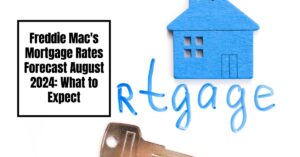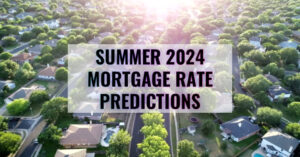As we delve into Freddie Mac's comprehensive mortgage market forecast, it’s crucial to understand the current climate that influences mortgage rates, home sales, and consumer behavior. The latest report reveals a complex picture, with Freddie Mac's Mortgage Market Forecast indicating that housing demand remains sluggish, despite some recent declines in mortgage rates. This situation has led many potential homebuyers to exercise caution, causing a ripple effect throughout the housing market.
Freddie Mac's Mortgage Rates Forecast August 2024
Key Takeaways
- Mortgage Rates: The rate on a 30-year fixed mortgage averaged 6.85% in July.
- Low Refinancing Activity: Q2 2024 saw a refinance volume drop to $62 billion, the lowest since 1996.
- Homeownership Trends: The homeownership rate fell to 65.6% in Q2 2024, a decline from the previous year.
- Impact on Housing Supply: An increase in rental units by 0.8 million units over the year highlights the shift toward renting over buying.
- Future Predictions: Freddie Mac forecasts a modest increase in home prices over the next two years by approximately 2.1% in 2024 and 0.6% in 2025.
Current Overview of the Mortgage Market
Freddie Mac's latest report indicates that despite a favorable dip in mortgage rates, overall housing demand has not rebounded as anticipated. The average rate for a 30-year fixed mortgage was reported at 6.85% in July, which shows a slight decrease from 6.92% in June. However, this reduction did little to stimulate buyer interest, as the Mortgage Bankers Association (MBA) reported a 2.6% drop in mortgage activities month-over-month, alongside a modest year-over-year increase of 0.2%.
Understanding Buyer Behavior
Buyer behavior reveals an intriguing paradox in the housing market. Many potential homebuyers express an expectation that mortgage rates will continue to decline, leading them to postpone home purchases. This waiting game contributes to ongoing demand weakness, as buyers hold out for potentially lower rates. The outcome is that while prevailing rates are down, the anticipation of further decreases has subdued immediate consumer activity:
- Deferred Decisions: Prospective buyers are opting to wait, which dampens immediate activity in the market.
- Supply Constraints: With reduced competition among buyers, the overall supply of homes for sale is not significantly improving.
The State of Refinancing
Another notable aspect of the current market is the substantial decline in refinancing activity. According to Freddie Mac, the refinance volume in Q2 2024 plummeted to $62 billion, marking the lowest level since Q3 1996. The first half of 2024 recorded a refinancing volume of $147 billion, a striking drop compared to previous years when refinancing was a popular option for homeowners looking to take advantage of lower rates.
- Lock-in Effect: Homeowners are largely refraining from refinancing, primarily due to the lock-in effect. Many homeowners secured their existing mortgages at lower rates and are wary of taking on new loans at current higher rates.
- Retention of Existing Loans: As a result, homeowners are choosing to retain their existing mortgages, contributing to the overall slowdown in refinancing activity.
Homeownership Trends
The homeownership rate in the U.S. decreased to 65.6% in Q2 2024, down from 65.9% a year earlier. This decline resonates strongly in the context of high mortgage rates and inflated home prices. Several dynamics are at play regarding homeownership trends:
- Increase in Total Units: Between Q2 2023 and Q2 2024, the total number of housing units rose from 145.1 million to 146.6 million, illustrating a growth trend but not necessarily translating into increased homeownership.
- Shifts to Renting: The notable increase in renter-occupied units, which climbed by 0.8 million, highlights that many individuals are opting to rent rather than buy. With the number of owner-occupied units rising by only 0.5 million, the trend suggests a significant shift toward more individuals seeking rental arrangements due to affordability concerns.
Future Forecasts by Freddie Mac
Looking forward, Freddie Mac anticipates a modest increase in housing demand. Although the overall expectation for home sales remains subdued, especially with the current rate lock-in effect, there is hope for a resurgence in activity. Some key projections include:
Projected Home Sales
- Gradual Increase: A modest increase in home sales is expected throughout 2024 and 2025, although sales are projected to remain below 6 million units annually. Factors influencing this increase include:
- Anticipated easing in mortgage rates.
- Gradual improvements in buyer sentiment as affordability improves.
Home Price Projections
- Incremental Growth: Freddie Mac predicts that home prices will rise by 2.1% in 2024 and 0.6% in 2025. These projections suggest a continued appreciation in home values driven by solid demand amidst constrained inventory levels:
- Impact of Demand: Factors such as rising interest from first-time homebuyers and limited housing supply will support price increases, even as overall market conditions remain challenging.
Potential Impact of Lower Mortgage Rates
As mortgage rates are expected to cool, the first-time homebuyer segment is anticipated to show significant growth. This demographic, often delayed owing to high rates and prices, may start entering the market more robustly as conditions improve. Several trends may emerge:
- Increased First-Time Homebuyer Participation: Lower rates could help draw first-time homebuyers back into the market, supporting demand and stimulating the purchase segment.
- Limited Inventory: Even if rates decrease, a persistent inventory shortage from a decade of underbuilding could keep competitive pressures high among buyers.
Conclusion
In summary, while Freddie Mac's mortgage market forecast offers a glimmer of hope through expected increases in homeownership and a gradual tick in home values, challenges remain clear. The interplay between rates, consumer sentiment, and inventory will dictate market dynamics well into 2025. Homebuyers are encouraged to stay informed and consider the evolving landscape carefully as opportunities may arise in what has been a frustrating market.
FAQs
What is Freddie Mac's prediction for mortgage rates in 2024?
Freddie Mac anticipates modest declines in mortgage rates throughout 2024, which may help spur housing demand.
How has the homeownership rate changed recently?
The homeownership rate decreased to 65.6% in Q2 2024, down from 65.9% the previous year.
What is the current refinancing volume according to Freddie Mac?
The refinancing volume in Q2 2024 was $62 billion, the lowest since 1996.
Are home prices expected to rise or fall in 2024?
Home prices are forecasted to increase by approximately 2.1% in 2024.
What trends are impacting first-time homebuyers in the current market?
First-time homebuyers are facing challenges due to high rates and prices but may experience increased opportunities if rates decline.
ALSO READ:
- Will Mortgage Rates Ever Be 3% Again: Future Outlook
- Mortgage Rates Predictions for Next 2 Years
- Mortgage Rate Predictions for Next 5 Years
- Mortgage Rate Predictions for 2025: Expert Forecast
- Prediction: Interest Rates Falling Below 6% Will Explode the Housing Market
- Mortgage Rate Predictions: Why 2% and 3% Rates are Out of Reach
- How Lower Mortgage Rates Can Save You Thousands?
- How to Get a Low Mortgage Interest Rate?
- Will Mortgage Rates Ever Be 4% Again?








 A big part of my job is helping our clients project the most likely scenarios for the housing market. Now that we know who will be President, my job just got easier because we have four years of experience with Obama and a divided Congress, so we know what we are getting.
A big part of my job is helping our clients project the most likely scenarios for the housing market. Now that we know who will be President, my job just got easier because we have four years of experience with Obama and a divided Congress, so we know what we are getting.